Graham Reid | | 7 min read

The first thing you see when you come out of the Bernauerstrasse underground station in Berlin is the ruin: no houses down one side of the road, just overgrown and scrappy wasteland spotted with slabs of crumbling concrete and rusting reinforcing steel. It is as if the homes which once stood here had been hastily bulldozed and their skeletons left for the weeds to take possession of and grow through.
And that is exactly what happened.
Bernauer Strasse is one of the places where the Berlin Wall once stood -- a part of it remains down the road -- and this scar through the suburbs is a brutal reminder of the division which once existed in this city, as deeply etched in the world's consciousness as it is carved through these streets.
Berlin today is a trendy tourist destination. The city bristles with thrilling and innovative architecture, hip nightclubs and promise. Its acceptance of bohemianism, much vaunted liberal climate (which has yet to be seriously tested) and vibrant arts scene jostle for the visitor's attention with interesting river cruises, the old Reichstag parliament building with its soaring cupola, and the Egyptian collection -- including the movingly beautiful bust of Nefertiti -- in the Altes Museum.
At the Berlin Film Museum at Potsdamer Platz there are extraordinary permanent exhibitions of German cinema and Marlene Dietrich's remarkable life (and her equally astonishing clothes). Around the city there are cabaret shows, jazz and blues in clubs like the Quasimodo, upmarket restaurants with cutting-edge interior design -- such as the hipper-than-thou Kula Karma on Rosenthaler Strasse -- and a burgeoning DJ scene.
In the shops at Galeries Lafayette international designer labels, gourmet food and the interior design draw the moneyed, the hungry and the curious.
Oh, and there is also the hotel where Michael Jackson hung his baby out the window.
Berlin is, as they say, going off.
Yet it is also a city which, even now, lives with its recent past.
You can take a 20 minute boat trip down the Spree and be awed by the angular modern architecture which spread out west of the old Reichstag.
However a 20 minute train trip will take you through the outer suburbs of old East Germany where you will encounter bomb-site buildings in rundown, gap-toothed streets. Here the only colour comes from the graffiti kids' scribbles.
In suburbs like Lichtenberg and Marzahn the neo-Nazis of the National Democratic Party have strong support, but these are areas tourist tend to -- wisely -- avoid.
Berlin may be repositioning itself in the vanguard of the European arts scene once more, but only the wilfully blind would choose to ignore the other aspect of this city of some 3.5 million. It is hard to avoid seeing drugs being sold on railway platforms, pierced and tattooed kids slumped in corners asking for money, and -- of course -- the city's darker moments from its past.
You can, if you so wish, engage this other side and do a kind of Morbid History Tour of Berlin: you can stand in Bebelplatz opposite Humboldt University where the Nazis burned books; visit the site where 18-year old Peter Fechtner jumped the Wall in August 1962, was shot by East German guards and left to die; and watch the footage of the construction of the Wall in 1961 and its appalling consequences in the Dokumentationszentrum (Documentation Centre) on Bernauer Strasse.
If you join the group outside the McDonald's opposite Zoo Station you can take a Third Reich walking tour, or maybe link up with the other party which is heading off for a look around Sachsenhausen Concentration Camp.
And there's always the Holocaust section in the Judisches Museum.
There seems a willing clientele for this kind of ghoulish tourism these days, and Berlin can provide it in depressing abundance.
When I was growing up in the 60s Berlin meant The Wall. At intermediate school we memorised the complexity of politics we couldn't understand by a simple mantra: "We're West".
By extension they, whoever "they" were, were the East.
The Wall was something which appeared on television looking relentlessly grim, and the only time Berlin made the news was because of some tragic event. Occasionally there'd be something in the newspapers about Rudolf Hess, the sole prisoner in Spandau. Maybe a grainy monochrome photograph of the old man walking alone in the yard.
Berlin always seemed to be in black and white.
Later in life Berlin, and Germany, began to mean something different to me. Art History studies threw wild German Expressionism and austere Bauhaus architecture into the mix.
Berlin seemed complex, not easily defined. But I always imagined it to be cold.
Then in 1989 the Wall came down.
Just as our image of Russian women changed when glasnost kicked in -- they were no longer aged frumps in headscarves but sexually available blondes -- so our image of Berlin changed. More recently Berlin was a city which attracted for its architecture: I couldn't count the number of articles I have read about the renovation of Potsdamer Platz where the interior of the Sony building soars like aerial poetry.
Berlin was also where David Bowie, Iggy Pop and U2 all recorded terrific albums -- but even they were gloomy affairs, suffused in a shadowy spirit and influenced by the city which shaped them. Critics would sagely say "recorded in Berlin" and we would nod as if that meant something.
Few of us -- critics or listeners -- had ever been there, but we had codified Berlin: The Wall, Zoo Station, junkies, guards in watchtowers, Spandau, barbed wire, decadence . . .
It came as no surprise that Nick Cave, that explorer of the dark arts, should own a club in Berlin.
And so -- with all this stew of Berlin in my subconscious -- I went to this city where a problematic past and troublesome present collide.
We arrived as their election result was in limbo -- coincidentally so was ours -- and there was uncertainty in the air. People poured over newspapers, but mostly went about their business as usual. It was, however, a peculiarly disconcerting backdrop in which we found ourselves.
We were staying in Mitte, once in old East Germany and now a thriving centre of idiosyncratic bars and restaurants where smoking seemed mandatory. There was provocative art in small galleries, intelligent graffiti ("Coincidence is just another word for synchronicity"), well-stocked porn shops, and kebab joints. Berliners appear to have adopted the kebab as a local dish in the same way the English have taken to curries.
Our hotel, the Andechser Hof, proved to be one of the better places and was reasonably priced. The new owners had put their money in the right places -- excellent modern bathrooms and good beds -- and it was within a few minutes walk of the Berlin Wall at Bernauer Strasse.
The Wall still looms large in the consciousness of Berliners but it has also been transformed into Cold War tourism which is turning pain into profit. You can take a bike tour along 11 kilometres of it, climb up a border watchtower and "see where the desperate refugees jumped from their houses to get into the West".
Down by the reconstructed Checkpoint Charlie you can buy bits of the Wall sealed in plastic bookmarks (no certificate of authenticity accompanying however). The inhumane realities of Cold War politics probably don't mean much if you are chowing down on sauerkraut and a currywurst in Checkpoint Charlie eateries, or buying the t-shirt which reads "you are now entering the American sector".
You can also buy East German kitsch (I got two Lenin badges for 5 euro each and the military jackets looked kinda cool) or snap up Wall shot glasses, fridge magnets, postcards, photographs, beanies and all the usual gift store detritus. The t-shirts will get laughs back home.
But up at Bernauer Strasse -- and elsewhere, the Wall was 160 kilometres long -- where people's homes were torn down by pickaxe or blown to pieces, where East German guards shot at and often killed those attempting to escape, where tunnels were dug by students in the West from homes and shops near the Wall, you get a better feel for this dark and anachronistic period of recent history.
And when you look at the dates of the escapes and shootings it all seems uncomfortably, and absurdly, recent. While people in the West were enjoying Beatlemania, hippies, Dallas, Farrah Fawcett Majors and right up until they were dancing to Duran Duran, those in East Berlin lived in a world of monochrome until the Wall was torn down in 1989 -- which might explain why 80s music is so big in Berlin.
You can hardly finish your beer before Blondie comes on the soundsystem. Or even Bowie's slightly more obscure Boys Keep Swinging from his late-Berlin phase. There is a subtext of benign nostalgia for those heady days and it even has a name, Ostalgie, nostalgia for the East (Ost).
The once derided Trabant is now a kitsch artefact of the old East and you can be taken on Trabi trips around the city. Unlike the schism between North and South Korea where those in the old style Stalinist North are kept ignorant of the outside world and fed military parades, those locked inside East Germany could tune their radios and televisions to what was happening on the other side of the Wall. It might have sometimes seemed depraved and puzzling -- how could you fathom Grace Jones or Boy George? -- but at least it was interesting and colourful.
The right wing American humorist PJ O'Rourke was probably more right than many liberals would concede: these people didn't want freedom and democracy, they wanted Levi jeans and rock'n'roll.
And now, to some extent, they've got them.
But whatever rapprochement happened in those optimistic months after the Wall came down has slowly been eroded. Germany has serious economic problems and unemployment runs on average at 12 percent. But it is much higher -- and highly visible -- in the old East and that creates some resentment among those who feel they are having to pay to bring their Cold War cousins into the 21st century. As a tourist however, that doesn't matter much when you are in one the dozens of small bars in student area north of Mitte.
Here holes in walls and old buildings have been turned into smoke-filled funky bars and clubs. Here there seems a willingness to take on the challenges and opportunities of capitalism.
But there are contradictions everywhere in Berlin: hardcore techno co-exists with the hippie hangovers; the old Renaissance-style Berliner Dom was only completed early last century; and Berlin's tallest structure, the television tower which was in old East Germany, looms over the nearby Marienkirche (St Mary's Church with its Dance of Death fresco) and the park where there are thumping great statues of Karl Marx and Friedrich Engles.
You can go to the beach right in the middle of the city. The Strandbar sets up deckchairs outside its Tiki-bar premises and people sun themselves on the modest strip of "sand" and grass by the Spree.
The city is full of such surprises and photo opportunities: the Brandenburg Gate, the Reichstag, the bank in Pariser Platz designed by Frank Gehry which is deceptively ordinary on the outside but explodes with his signature style in the eye-bending foyer . . .
Berlin is all the things its tourism companies would have you believe: exciting and vibrant, historic and cutting edge, full of possibilities. But it is always going to be something else also; the perversity of Nazism and the divisive consequences after its bloody defeat. In the Dokumentationszentrum you read the history of the Wall and look through the list of names, photographs and ages of people who died in their attempt at freedom -- more than 150 victims of this shadow period in Berlin's frequently troubled recent history.
And an abiding image is the rubble -- only now being cleared -- along Bernauer Strasse.
It is a reminder of when humanity fell into a void of its own making.

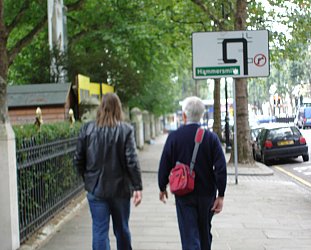
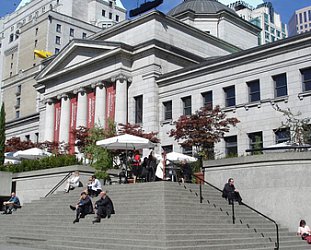
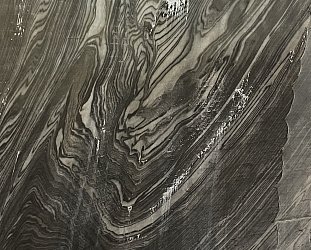
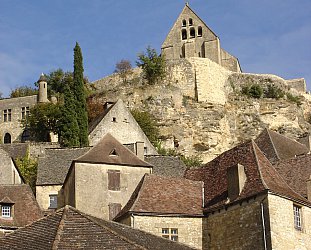
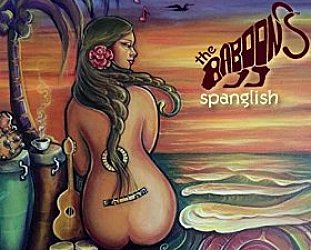
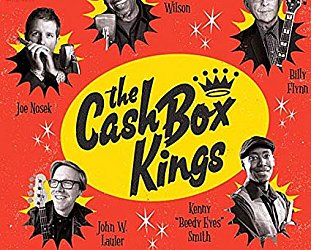
post a comment